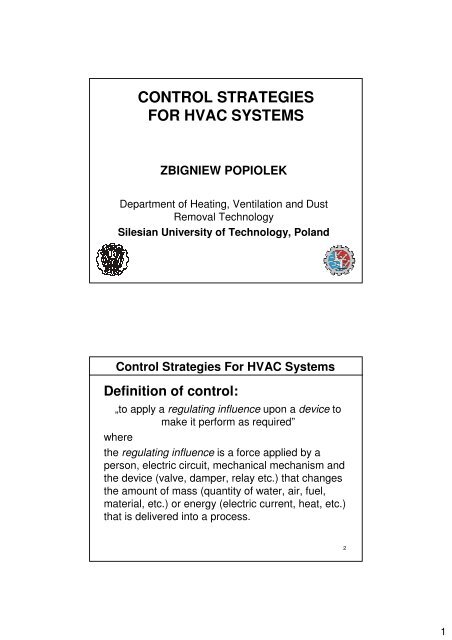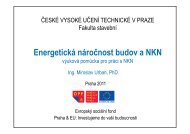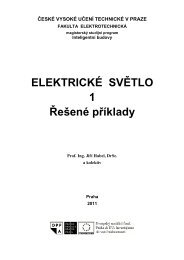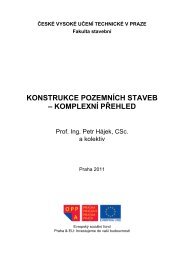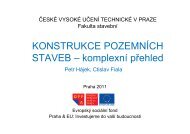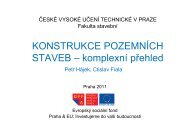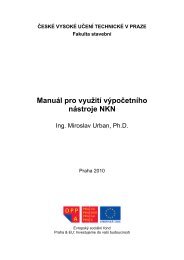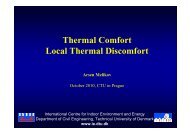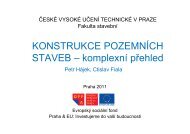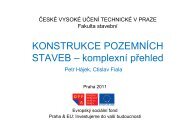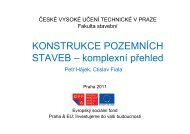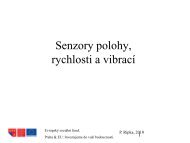CONTROL STRATEGIES FOR HVAC SYSTEMS
CONTROL STRATEGIES FOR HVAC SYSTEMS
CONTROL STRATEGIES FOR HVAC SYSTEMS
You also want an ePaper? Increase the reach of your titles
YUMPU automatically turns print PDFs into web optimized ePapers that Google loves.
<strong>CONTROL</strong> <strong>STRATEGIES</strong><br />
<strong>FOR</strong> <strong>HVAC</strong> <strong>SYSTEMS</strong><br />
ZBIGNIEW POPIOLEK<br />
Department of Heating, Ventilation and Dust<br />
Removal Technology<br />
Silesian University of Technology, Poland<br />
1<br />
Control Strategies For <strong>HVAC</strong> Systems<br />
Definition of control:<br />
„to apply a regulating influence upon a device to<br />
make it perform as required”<br />
where<br />
the regulating influence is a force applied by a<br />
person, electric circuit, mechanical mechanism and<br />
the device (valve, damper, relay etc.) that changes<br />
the amount of mass (quantity of water, air, fuel,<br />
material, etc.) or energy (electric current, heat, etc.)<br />
that is delivered into a process.<br />
2<br />
1
Control Strategies For <strong>HVAC</strong> Systems<br />
Drawings<br />
of an AHU<br />
Exhaust Air<br />
Exhaust Air<br />
Dampers<br />
NC<br />
Return Air<br />
Dampers<br />
NC<br />
T<br />
Return Air<br />
T<br />
HWR<br />
HWS<br />
Outside Air<br />
Supply Air<br />
Dual Line<br />
Outside Air<br />
Dampers<br />
NC<br />
Filter<br />
T<br />
T<br />
Exhaust Air<br />
Dampers<br />
NC<br />
T<br />
EA<br />
Return Air<br />
Dampers<br />
NC<br />
RE<br />
HWR<br />
HWS<br />
Single Line<br />
OA<br />
T<br />
Outside Air<br />
Dampers<br />
NC<br />
Filter<br />
T<br />
T<br />
SA<br />
3<br />
Control Strategies For <strong>HVAC</strong> Systems<br />
Exhaust Air<br />
Dampers<br />
NC<br />
T<br />
EA<br />
RE<br />
Return Air<br />
Dampers<br />
NC<br />
HWR<br />
HWS<br />
OA<br />
T<br />
Outside Air<br />
Dampers<br />
NC<br />
Filter<br />
T<br />
T<br />
SA<br />
DI<br />
Analog Inputs<br />
DDC Panel<br />
Controller<br />
Algorithm<br />
Logic<br />
Code<br />
Schedules<br />
DO<br />
Analog Outputs<br />
An AHU and its Control System<br />
4<br />
2
Control Strategies For <strong>HVAC</strong> Systems<br />
Exhaust Air<br />
Dampers<br />
NC<br />
T<br />
H<br />
EA<br />
Return Air<br />
Dampers<br />
NC<br />
CHWR<br />
NC<br />
Chilled Water<br />
Valve<br />
NC<br />
CHWS<br />
NO<br />
NO<br />
Hot Water<br />
Valve<br />
HWR<br />
RE<br />
OA<br />
T<br />
Outside Air<br />
Dampers<br />
NC<br />
Filter<br />
T<br />
HWS<br />
3 o C<br />
LL<br />
T<br />
SA<br />
DI<br />
Analog Inputs<br />
DDC Panel<br />
Controller<br />
Algorithm<br />
Logic<br />
Code<br />
Schedules<br />
DO<br />
Analog Outputs<br />
High Limit Humidity Control Strategy<br />
5<br />
Control Strategies For <strong>HVAC</strong> Systems<br />
DDC<br />
DI<br />
Analog Inputs<br />
DDC Panel<br />
Controller<br />
Algorithm<br />
Logic<br />
Code<br />
Schedules<br />
DO<br />
Analog Outputs<br />
Direct Digital Control or Distributed Digital Control<br />
Terms Direct and Distributed differences between<br />
these control systems and analogue electronic or<br />
pneumatic control systems.<br />
Term Distributed underscores ability to increase<br />
system reliability, speed, computing power by dividing<br />
the control functions of a facility among a number of<br />
smaller microprocessor based panels. Each of these<br />
panels can operate alone or as a part of larger system.<br />
6<br />
3
Control Strategies For <strong>HVAC</strong> Systems<br />
DDC<br />
DI<br />
Analog Inputs<br />
DDC Panel<br />
Controller<br />
Algorithm<br />
Logic<br />
Code<br />
Schedules<br />
DO<br />
Analog Outputs<br />
• Direct Digital Control is based on computer<br />
processor, with electronic or pneumatic actuators<br />
• Nearly all current DDC products can be<br />
programmed with sophisticated control sequences<br />
• DDC allows central delivery system setpoints to be<br />
optimized based on actual zone load conditions<br />
ensuring rational energy management or occupants<br />
comfort<br />
7<br />
Control Strategies For <strong>HVAC</strong> Systems<br />
SEQUENCE (DESCRIPTION)<br />
OF OPERATION<br />
It thoroughly describes the intended operation of<br />
the control system.<br />
The sequence of operation is developed by the<br />
mechanical engineer together with the control<br />
system’s application engineer.<br />
It is reference document used during installation,<br />
operation and commissioning of <strong>HVAC</strong> system.<br />
8<br />
4
Control Strategies For <strong>HVAC</strong> Systems<br />
ORGANIZATION OF A<br />
SEQUENCE OF OPERATION<br />
1. System overview<br />
Briefly describes the mechanical equipment and<br />
processes being maintained by the control system.<br />
2. Energy management overview<br />
Briefly describes the energy management<br />
strategies that are incorporated into the system’s<br />
operation.<br />
9<br />
Control Strategies For <strong>HVAC</strong> Systems<br />
3. Pre-conditioning operation<br />
Describes how the equipment operates during the<br />
period preceding the building's occupied period.<br />
4. Occupancy operation<br />
Describes how the processes and their control<br />
loops operate during the period when building is<br />
occupied.<br />
Is broken down into subsections for each process:<br />
- Fan operation<br />
- Static pressure control<br />
10<br />
5
Control Strategies For <strong>HVAC</strong> Systems<br />
- Temperature control<br />
Mixing air<br />
Supply air<br />
Zone<br />
- Humidity control<br />
- Zone pressurisation<br />
- Lighting control<br />
- Preliminary equipment control<br />
Boilers<br />
Chillers<br />
Cooling towers<br />
11<br />
Control Strategies For <strong>HVAC</strong> Systems<br />
5. Unoccupied operation<br />
Describes how the processes and their control<br />
loops operate during the period following occupied<br />
time and ending when the pre-conditioning mode<br />
begins.<br />
Each subsections listed under the Occupancy<br />
operation mode are also described in this section.<br />
6. Emergency strategies<br />
Describes the response of the affected control<br />
loops in the event an emergency condition such as<br />
smoke, fire, freeze or fault occurs.<br />
12<br />
6
Control Strategies For <strong>HVAC</strong> Systems<br />
7. Temperature setpoints and occupied<br />
schedules<br />
It contains tables or schedules referenced in the<br />
other sections. Possible schedules are:<br />
Mixed Air Reset Schedule<br />
Supply Air Reset Schedule<br />
Hot Water Reset Schedule<br />
Occupancy Schedule<br />
Unoccupied Setpoint Tables<br />
Valves Sequencing Schedules<br />
8. Other sections<br />
Valuable operation information not described under<br />
any of the above section.<br />
13<br />
Control Strategies For <strong>HVAC</strong> Systems<br />
Control Strategies<br />
• Scheduling<br />
• Optimum Start<br />
• Optimum Stop<br />
• Night Setback/ setup<br />
• Load Based Control<br />
• PID Loops<br />
• Minimum Outside air<br />
control<br />
• Discharge air reset<br />
• Chilled water reset<br />
• Free Cooling<br />
• Heating resets<br />
• Space setpoint reset<br />
• Pressure resets<br />
• Evening Purge<br />
14<br />
7
Control Strategies For <strong>HVAC</strong> Systems<br />
Scheduling<br />
1. Mixed Air Reset Schedule<br />
2. Supply Air Reset Schedule<br />
3. Hot Water Reset Schedule<br />
4. Occupancy Schedule<br />
5. Unoccupied Setpoint Tables<br />
6. Valves Sequencing Schedules<br />
eg.<br />
Outside Air Temperature<br />
Supply Air Setpoint<br />
-15 o C 20 o C<br />
20 o C 13 o C<br />
15<br />
Control Strategies For <strong>HVAC</strong> Systems<br />
Optimum Start<br />
• One of the oldest EMS strategies<br />
• Basically takes into account Outside Air<br />
Temperature, Zone Temp & recovery ability of<br />
<strong>HVAC</strong> equipment<br />
• Starts the equipment just early enough to meet<br />
setpoint at the beginning of occupancy<br />
• Decide if you want optimum start heating or<br />
cooling or both<br />
• Keep outdoor air dampers closed during a<br />
morning warm-up optimum start period<br />
16<br />
8
Control Strategies For <strong>HVAC</strong> Systems<br />
Optimum Stop<br />
• Stops the facility systems prior to scheduled stop<br />
time to let the building “coast” to the end<br />
• Use the mass of the building and comfort delivery<br />
systems to maintain comfort without heating or<br />
cooling<br />
• Especially good for electric heat<br />
• Optimum stop ~30 to 45 minutes early<br />
• Don’t turn the air off!! (may depend on<br />
occupants)<br />
17<br />
Control Strategies For <strong>HVAC</strong> Systems<br />
Night Setback/Setup<br />
• with resetable setpoint<br />
• with fixed setpoint<br />
• Winter & Summer<br />
• Make sure you can recover from it<br />
• Use Optimum Start to recover properly<br />
• Be sure that Outside Air damper is closed<br />
18<br />
9
Control Strategies For <strong>HVAC</strong> Systems<br />
Minimum Outside Air<br />
• How much Outside Air is needed<br />
• What is 10% And 10% of what<br />
• Variable air Volume challenges<br />
• Does mixed air temp control satisfy need<br />
• Outside Air need based on CO 2 concentration<br />
19<br />
Control Strategies For <strong>HVAC</strong> Systems<br />
Occupancy Sensors<br />
• Use occupancy sensors for lighting and zonelevel<br />
<strong>HVAC</strong> control<br />
• Can also use window sensors to turn off <strong>HVAC</strong><br />
when windows are open<br />
20<br />
10
Control Strategies For <strong>HVAC</strong> Systems<br />
Free Cooling<br />
• Only valid if part of load is handled by AHU’s with<br />
Outside Air economizer and other loads that<br />
need chilled water all the time<br />
• When AHU’s are running in cold weather, start<br />
CHWP’s and allow water thru AHU coils to cool<br />
down chilled water loop for loads needing chilled<br />
water in winter<br />
21<br />
Control Strategies For <strong>HVAC</strong> Systems<br />
Evening Purge<br />
• If outdoor air temp is cool, and space is warm,<br />
flush the building<br />
• Keeps the building from overheating at night<br />
• Requires ~ 5 o C difference between OAT and<br />
space temp (OAT


